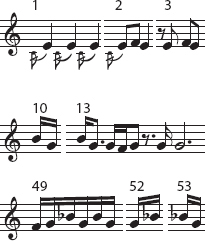On the Boundaries of Time

Terry Riley, In C. Copyright © 1964 by Associated Music Publishers, Inc. (BMI) International Copyright Secured. All Rights Reserved. Used by permission.
Sonority is one of two areas in which avant-garde music in its post–World War II phase made its greatest breakthroughs. The other area was time and rhythm. To understand one aspect of this development, let us try to contrast two radically different pieces of music. One is a tiny piece by Schoenberg’s student and friend Anton Webern (see page 327), the fourth of his Five Orchestral Pieces of 1913. Contrast Webern’s tiny orchestral piece with In C, a famous avant-garde work from the 1960s by the American composer Terry Riley. In C lasts for about forty-five minutes. During this time the instruments freely repeat over and over again a set of fifty-three tiny melodic figures that spell out only three harmonies — three harmonies drawn out over the music’s total span. The pitches and rhythms are simple, indeed deliberately soothing. This might be described as a very long time segment of very low intensity.
With both Webern and Riley, we measure time in the same units: minutes and seconds. Yet the feeling of time is very different in the two. It is like the difference between one minute at the end of a tied basketball game and one minute in the middle of an all-night truck run across South Dakota.
Such contrasting perceptions of time now came to be widely explored by musicians of the avant-garde. Webern’s intense experience of time made him a major influence in the postwar years, even though he died at the end of World War II. Riley’s In C and works like it became prophetic of a later development in music which gathered force in the 1970s and 1980s, minimalism (see page 369).
